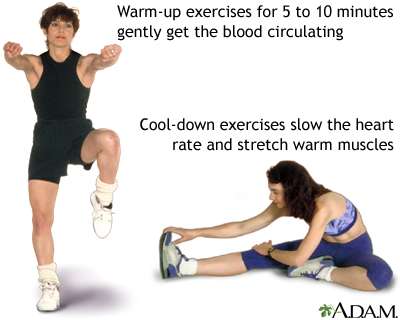In today’s fast-paced world, finding time for exercise can be a challenge. But did you know that skipping warm-up and cool-down sessions can have a significant impact on your workout and overall fitness? Properly warming up before exercise and cooling down afterward play a crucial role in preventing injuries, improving performance, and aiding in muscle recovery. In this article, we will explore the importance of these often overlooked components of a workout and how incorporating them into your routine can benefit your fitness journey. So, let’s dive in and discover why warming up and cooling down should never be underestimated.
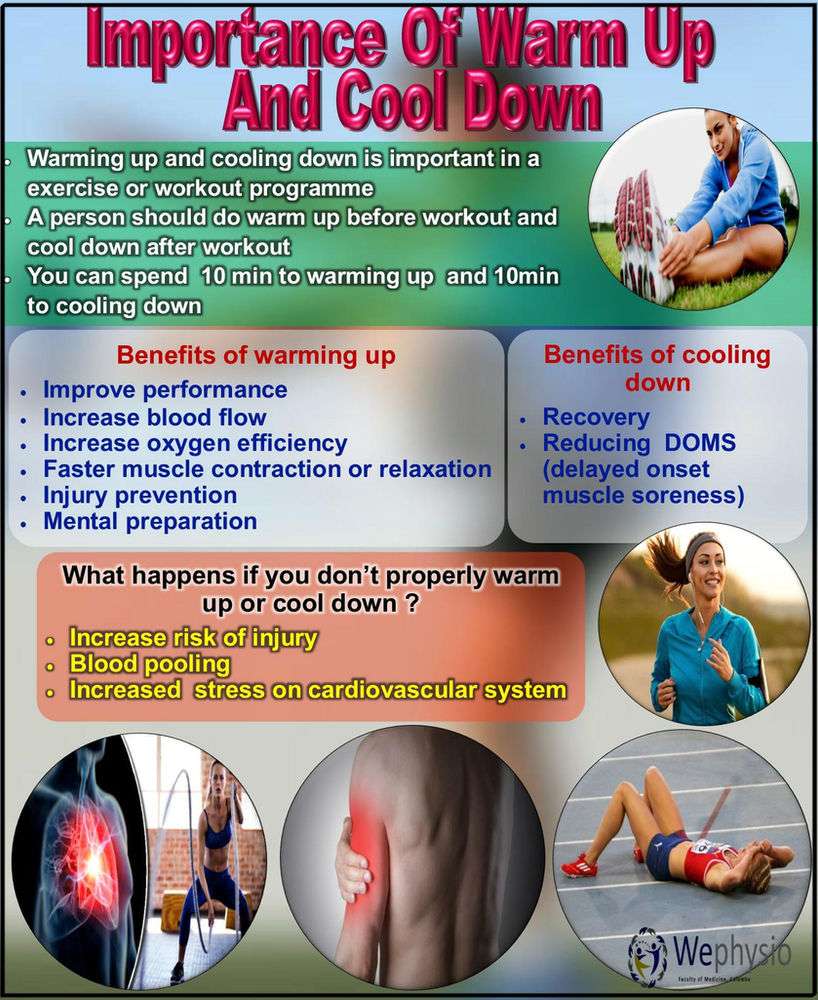
The Importance of Warming Up
Preparing the Body and Mind
Warming up before any physical activity is crucial to prepare your body and mind for the demands that lie ahead. It helps increase your heart rate, breathing rate, and blood flow to the muscles, which in turn warms up your muscles. This prepares them for the intense movements and actions that will be required during your workout or sports activity. Moreover, a warm-up also activates the nervous system, making it more responsive and efficient in coordinating your movements.
Improved Performance
One of the key benefits of warming up is enhanced performance. By gradually increasing your heart rate and warming up your muscles, your body becomes more primed for action. This leads to better overall performance, whether it’s in the context of running, weightlifting, cycling, or any other physical activity. Warming up allows your muscles to work at their full potential, leading to improved speed, strength, and endurance. It also helps improve your coordination, balance, and agility, enabling you to perform at your best.
Injury Prevention
Injuries can be debilitating and prevent you from engaging in your favorite activities. This is where warming up plays a vital role in injury prevention. By gradually increasing the intensity of your movements and stretching your muscles, warming up helps prepare them for the stress they will undergo during exercise. It helps raise the temperature of your muscles, making them more flexible and reducing the risk of strains, sprains, and other muscular injuries. Warming up also helps improve your body’s neuromuscular coordination, reducing the chances of tripping, falling, or losing balance during physical activity.
Increased Range of Motion
When your muscles are cold, their flexibility is limited. Warming up helps increase your body’s range of motion by gently stretching your muscles and increasing blood flow to the joints. This increased range of motion can be beneficial in various activities, such as sports that require a wide range of motion, yoga, or weightlifting. By improving your flexibility, warming up allows you to move more freely, with greater ease and comfort, reducing the risk of muscle strains or joint injuries.
Enhanced Circulation and Oxygenation
During a warm-up, your heart rate and blood flow increase, which helps improve circulation throughout your body. This increased blood flow delivers vital nutrients and oxygen to your muscles, ensuring they are adequately nourished for the upcoming demands. Efficient circulation also helps remove waste products, such as lactic acid, from your muscles, reducing the onset of muscle fatigue. When your muscles are well-oxygenated, they can perform at their best, with improved endurance and reduced risk of muscle cramps or soreness.
How to Warm Up
Dynamic Stretching
Dynamic stretching involves active movements that take your joints and muscles through a full range of motion. Examples of dynamic stretching exercises include arm circles, walking lunges, high knees, and leg swings. These exercises help warm up your muscles while simultaneously increasing their flexibility and range of motion. Dynamic stretching is particularly effective before activities that involve movement, such as running, dancing, and sports.
Joint Rotations
Joint rotations are a gentle and effective way to warm up your joints before any physical activity. By moving your joints in a circular motion, you lubricate them and improve their mobility, reducing the risk of joint stiffness or injury. Common joint rotations include neck rolls, shoulder circles, wrist circles, hip circles, knee movements, and ankle rotations. Performing joint rotations as part of your warm-up routine is essential to ensure your joints are well-prepared for the movements and stresses they will experience during exercise.
Cardiovascular Exercise
Including a cardiovascular component in your warm-up routine is crucial to elevate your heart rate and stimulate blood flow throughout your body. This can be achieved through activities such as jogging in place, jumping jacks, skipping, or using cardio machines like treadmills or stationary bikes. The goal is to gradually increase your heart rate and breathing rate, getting your body ready for the demands of your workout or sports activity. Cardiovascular exercise also helps improve your stamina and endurance, both of which are essential for optimal performance.
Sport-Specific Movements
For activities that involve specific movements, incorporating sport-specific exercises into your warm-up routine is highly beneficial. This allows your body to acclimate to the specific movements and patterns required in your chosen activity. For example, if you are a tennis player, warm up by practicing your forehand and backhand swings. If you are a dancer, perform some basic dance steps. By simulating the movements you will be doing during your activity, you mentally and physically prepare yourself, leading to improved performance and reduced risk of injury.
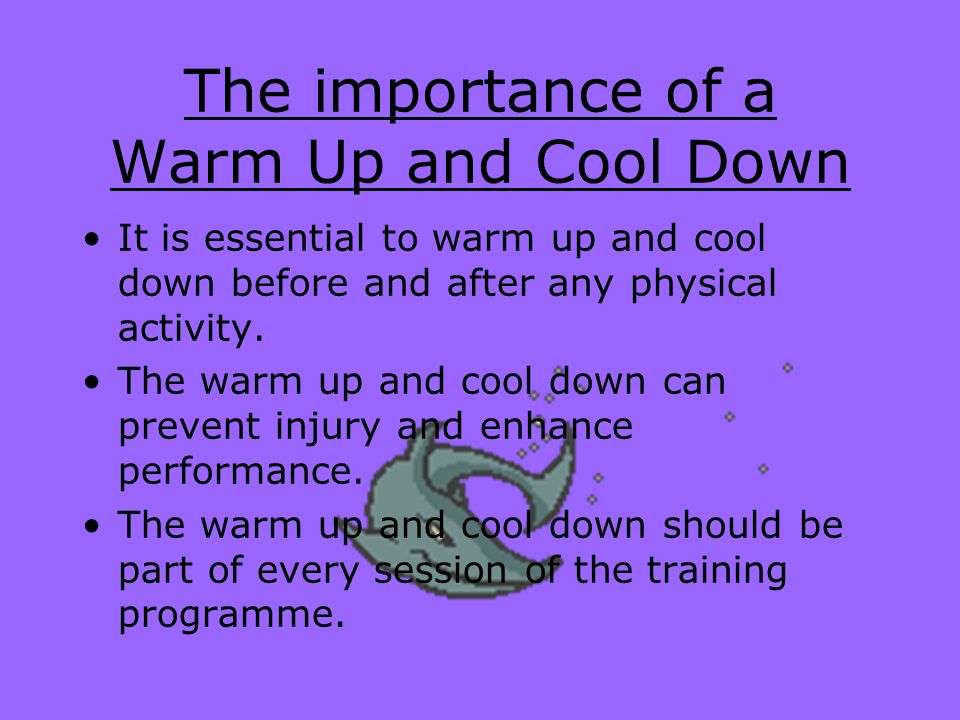
The Importance of Cooling Down
Promotes Recovery
Just as warming up is essential before physical activity, cooling down afterward is equally important. Cooling down allows your body to gradually transition from an intense workout or sports activity back to a normal resting state. It helps bring your heart rate, breathing rate, and body temperature back to baseline gradually. By gradually decreasing the intensity of your exercise, your body has the opportunity to gradually slow down and recover, reducing the chances of sudden fatigue or dizziness.
Helps Remove Waste Products
During intense exercise, your body produces metabolic waste products, such as lactic acid and carbon dioxide. Cooling down helps facilitate the removal of these waste products from your muscles by continuing to circulate blood to the muscles and promoting increased oxygenation. By aiding in the removal of waste products, cooling down helps reduce muscle soreness and fatigue that can occur after exercise. It also helps prevent the buildup of excess lactic acid, which can lead to muscle cramps or stiffness.
Gradual Decrease in Heart Rate
Cooling down after exercise allows your heart rate to gradually return to its resting rate. This gradual decrease in heart rate helps prevent abrupt changes in blood pressure, reducing the risk of dizziness or fainting. By allowing your heart rate to come down slowly, you facilitate a smoother transition for your cardiovascular system, preventing any unnecessary stress or strain on your heart.
Reduces Muscle Stiffness
After an intense workout or physical activity, your muscles are often tense and contracted. Cooling down helps relax and elongate your muscles, reducing muscle stiffness and soreness. By maintaining gentle movements and stretching during your cool-down period, you promote improved blood flow to the muscles, which helps distribute oxygen and nutrients while flushing out metabolic waste products. This promotes muscle recovery and reduces the likelihood of post-workout muscle tightness or discomfort.
How to Cool Down
Light Aerobic Exercise
Similar to the warm-up phase, light aerobic exercise serves as a beneficial component of the cool-down routine. Engaging in low-intensity activities such as walking, jogging, or cycling at a relaxed pace helps gradually lower your heart rate and breathing rate, while continuing to promote blood flow and circulation. Light aerobic exercise also aids in the removal of metabolic waste products and assists in the gradual cool-down process.
Static Stretching
Static stretching involves holding a stretched position for a period of time without movement. Including static stretches during your cool-down routine helps lengthen and relax your muscles. Focus on stretching the major muscle groups you targeted during your exercise session. Hold each stretch for 15-30 seconds, feeling a gentle pull without any pain. Common static stretches include hamstring stretches, calf stretches, quadriceps stretches, shoulder stretches, and chest stretches. Static stretching during the cool-down phase promotes muscle relaxation and flexibility.
Foam Rolling
Foam rolling, also known as self-myofascial release, involves using a foam roller to apply pressure to specific muscles to release tension and tightness. Foam rolling during the cool-down phase can help break up any knots or adhesions in your muscles, promoting better blood flow and reducing muscle soreness. Spend 1-2 minutes on each muscle group, using slow, controlled movements. Focus on areas that feel tight or tender. Foam rolling can be particularly effective for larger muscle groups like the quadriceps, hamstrings, back, and calves.
Deep Breathing
Deep breathing exercises are an effective way to help your body relax and enter a state of calmness during the cool-down phase. Practice deep belly breathing, inhaling deeply through your nose and exhaling slowly through your mouth. Focus on filling your belly with each inhale and fully exhaling all the air out. Deep breathing triggers the relaxation response in your body, reducing stress and tension while enhancing overall recovery.
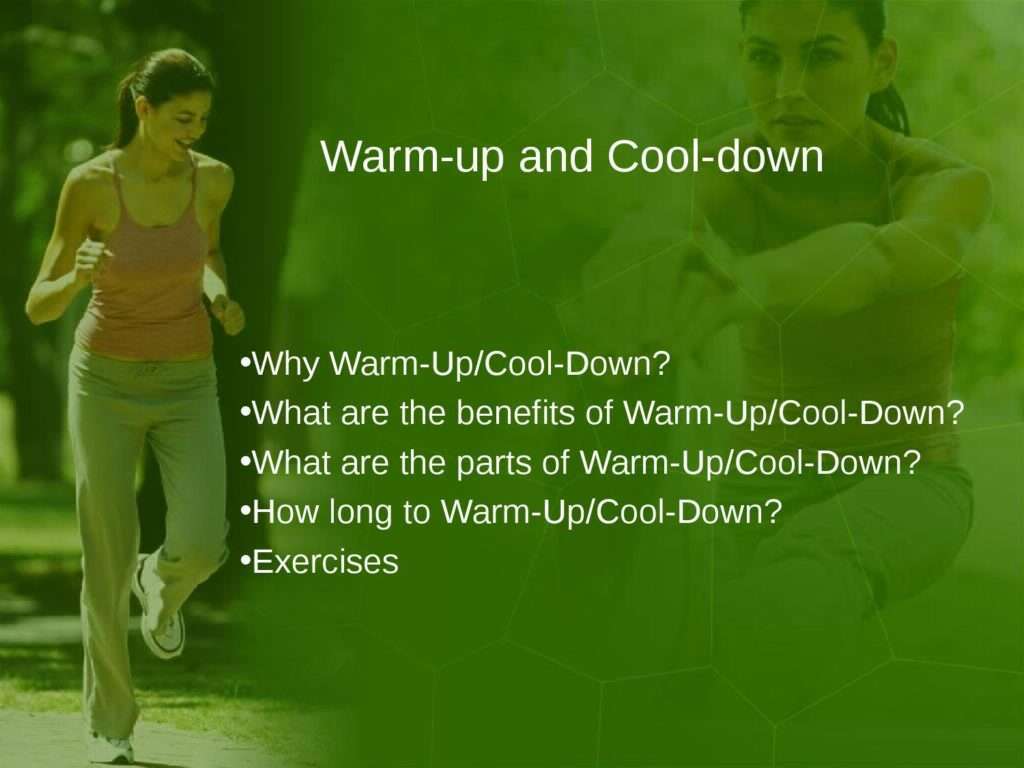
Warming Up and Cooling Down for Different Activities
Running
Before a run, start with a brisk walk or light jog, gradually increasing your pace over a few minutes. Incorporate dynamic stretches like leg swings, high knees, and walking lunges to warm up your leg muscles. After your run, cool down with a light jog or walk for a few minutes, followed by static stretches for your calves, quadriceps, hamstrings, and hip flexors.
Weightlifting
Prior to weightlifting, warm up by performing dynamic movements such as arm circles, bodyweight squats, and push-ups. Gradually increase the intensity by using lighter weights for a few sets. After your weightlifting session, cool down by performing light aerobic exercises like stationary biking or walking, followed by static stretches for the muscles you worked, such as your chest, shoulders, biceps, triceps, and legs.
Cycling
Start your cycling warm-up routine with a few minutes of light pedaling, gradually increasing the resistance and speed. Dynamic stretches such as hip circles, knee lifts, and standing quad stretches can help warm up the lower body. After your cycling session, cool down by pedaling at a slower pace for a few minutes, followed by static stretches for your calves, quadriceps, hamstrings, and hip flexors.
Team Sports
For team sports like soccer, basketball, or volleyball, begin with a light jog or brisk walk, gradually incorporating sport-specific movements such as side shuffles, quick direction changes, and short sprints. Include dynamic stretches that mimic the movements required in the sport. After the game or practice session, cool down with light aerobic exercises, followed by static stretches for the major muscle groups involved in the sport.
Common Myths about Warming Up and Cooling Down
Warming Up Makes You Tired
Contrary to popular belief, warming up actually energizes your body and prepares it for physical activity. It increases blood flow, heart rate, and oxygen delivery to your muscles, enhancing energy production. Warming up helps improve mental focus and alertness, making you feel more awake and ready to perform.
Cooling Down is a Waste of Time
Some people may view cooling down as unnecessary or a waste of time, but it plays a crucial role in aiding recovery and promoting overall fitness. Cooling down allows your body to gradually return to a resting state, reducing the risk of post-exercise lightheadedness or dizziness. It also helps prevent blood pooling in the extremities, which can lead to fainting or discomfort.
Stretching Before Exercise Prevents Injury
While stretching is an important component of a warm-up routine, research suggests that static stretching, where you hold a stretch for an extended period, performed before exercise may actually decrease performance and increase the risk of injury. Dynamic stretching and movement-based warm-up exercises are more effective in preparing your muscles for activity and reducing the chances of injury.
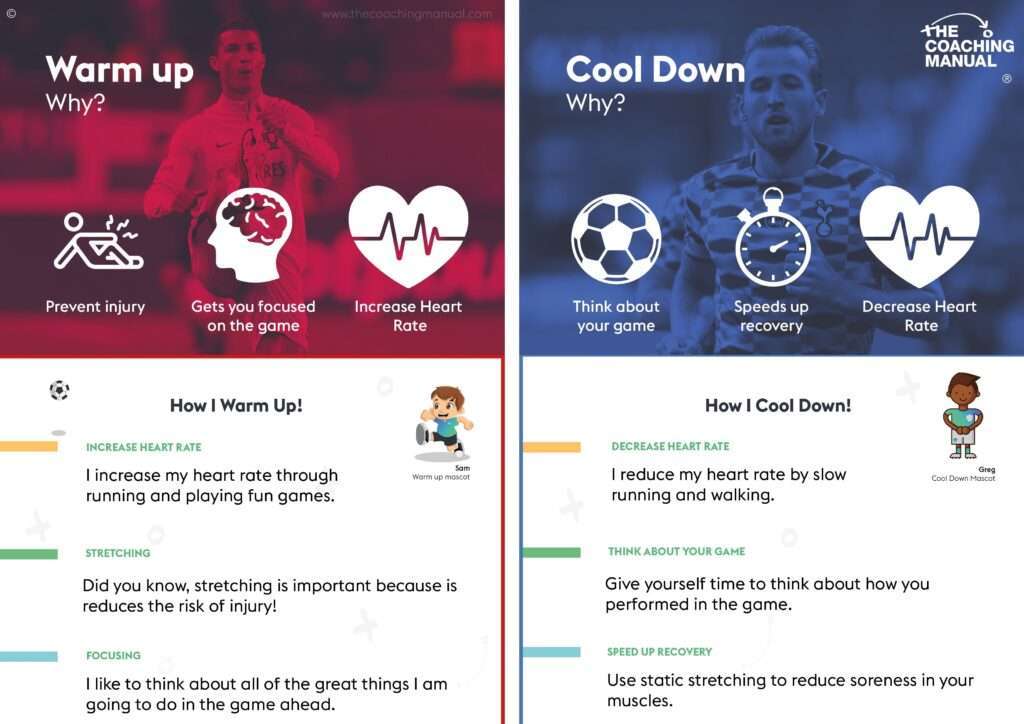
The Role of Warming Up and Cooling Down in Injury Rehabilitation
Promoting Healing and Rehabilitation
Warming up and cooling down are not only important for injury prevention but can also assist in the rehabilitation process. During injury recovery, it is crucial to gradually reintroduce physical activity to promote healing and strengthen the injured area. A well-structured warm-up allows the injured tissues to gently adapt to the demands of exercise, helping to rebuild strength and flexibility.
Increasing Blood Flow to Injured Tissues
Warming up helps increase blood flow to injured tissues, promoting enhanced oxygen and nutrient delivery. This increased circulation aids in the removal of waste products and supports the healing process. By incorporating appropriate warm-up exercises, you can stimulate blood flow and promote faster recovery of the injured area.
Reducing Muscle Imbalances
Injury can lead to muscle imbalances, where some muscles become weak while others become tight or overactive. An effective warm-up routine that targets the specific muscles affected by the injury can help address these imbalances. By gradually activating and strengthening the weakened muscles and stretching the tight ones, you promote proper muscle function and reduce the risk of further injury.
Tips for an Effective Warm Up and Cool Down
Allocate Sufficient Time
Give yourself ample time for warm-up and cool-down routines. A proper warm-up should last around 10-15 minutes, while the cool-down should be around 5-10 minutes. Rushing through these phases may lead to inadequate preparation or sudden fatigue.
Focus on Dynamic Movements
Prioritize dynamic movements during your warm-up routine, as they promote flexibility and enhance muscle activation. Incorporate exercises that mimic the movements you will be doing during your activity, gradually increasing the intensity as you progress.
Pay Attention to Specific Muscles
Consider the muscle groups that will be most engaged during your activity and focus on warming up those areas. Stretch and activate the muscles that you will be working the most, ensuring they are adequately prepared for the demands of your exercise or sport.
Gradually Increase and Decrease Intensity
In both the warm-up and cool-down phases, it is important to gradually increase or decrease the intensity of your exercises. This allows your body to smoothly transition between different energy levels and prevents sudden changes that may cause strain or discomfort.
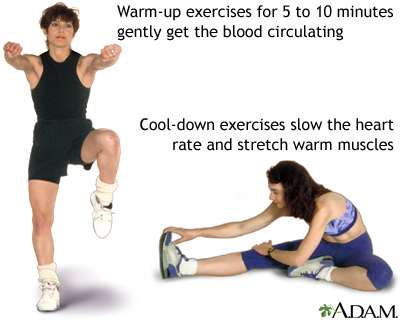
Common Mistakes to Avoid
Skipping the Warm Up and Cool Down
It can be tempting to skip the warm-up and cool-down phases and jump straight into your main activity or simply finish abruptly. However, by neglecting these essential components, you increase the risk of injury, hinder performance, and compromise your body’s ability to recover effectively.
Static Stretching before Exercise
Save static stretching for your cool-down routine. Performing static stretches before exercise can actually decrease muscle power and increase the risk of injury. Instead, focus on dynamic stretching and movement-based exercises to prepare your muscles for activity.
Ignoring Injury Warning Signs
While warming up and cooling down can reduce the risk of injury, it is important to pay attention to any warning signs from your body. If you experience pain, discomfort, or any unusual sensations during your warm-up or cool-down exercises, it is essential to stop and seek appropriate medical advice.
Conclusion
Warming up and cooling down are integral components of any physical activity or exercise routine. They prepare your body and mind for the demands of exercise, improve performance, prevent injuries, and aid in recovery. By incorporating dynamic movements, cardiovascular exercises, and sport-specific activities into your warm-up routine, you optimize muscle function and enhance overall performance. Similarly, cooling down with light aerobic exercises, static stretching, foam rolling, and deep breathing helps your body gradually return to a resting state, promotes muscle recovery, and reduces post-exercise discomfort. Prioritize these important phases before and after your workouts, ensuring a safe, enjoyable, and effective exercise experience. So next time you lace up your shoes or pick up those weights, remember the importance of warming up and cooling down to support your body in achieving its full potential.
